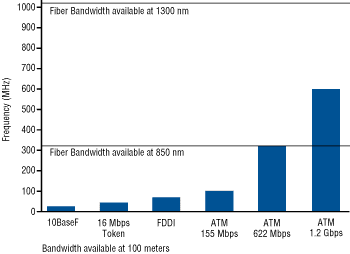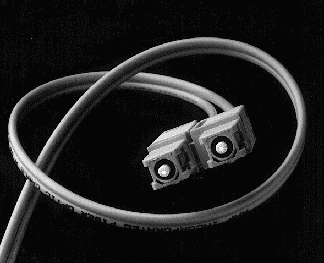
The bandwidth of optical fibers
comfortably surpasses the needs of today's applications
and gives room for growth tomorrow.
Title: Introduction to Fiber Optic Networking - Contents
Author: AMP, Inc.
Company: AMP, Inc.
Twisted pair cable is the most prevalent type of cable used in wiring new buildings. These cables come in several grades based on performance: Category 3 for applications to 16 MHz, Category 4 for applications to 20 MHz, and Category 5 for applications to 100 MHz. Each supports cable runs of up to 100 meters. A standard fiber optic cable for building use can handle applications of several hundred megahertz at distances in excess of 2000 meters. As will be discussed, Category 5 cable, the cable required for emerging high-speed applications like asynchronous transfer mode (ATM) and 100-Mbps Ethernet present some challenges in installation and operation.
The bottom line in the fiber versus copper debate is this: fiber has a performance edge. Copper, on the other hand, is a more widely understood and accepted technology. More important, the costs of fiber components are competitive with their copper counterparts. And if you add life cycle costs, including the costs of downtime and possible obsolescence, fiber is the better value.
The Seven Advantages of Fiber
Fiber optics would not even be considered if it did not offer distinct advantages over traditional copper media.
Information-carrying capacity. Fiber offers bandwidth well in excess of that required for today's network applications. The 62.5/125-micrometer fiber recommended for building use has a minimum bandwidth of 160 MHz-km (at a wavelength of 850 nm) or 500 MHz-km (at 1300 nm). Because bandwidth is a product of frequency and distance, the bandwidth at 100 meters is over 1 GHz. In comparison, Category 5 cable is specified only to 100 MHz over the same 100 meters.
With the high-performance singlemode cable used by the telephone industry for long distance telecommunications, the bandwidth is essentially infinite. That is, the information-carrying capacity of the fiber far exceeds the ability of today's electronics to exploit it.

Low loss. An optical fiber offers low power loss. Low loss permits longer transmission distances. Again, the comparison with copper is important: in a network, the longest recommended copper distance is 100 meters; with fiber, it is 2000 meters.
A principal drawback of copper cable is that loss increases with the signal frequency. This means high data rates tend to increase power loss and decrease practical transmission distances. With fiber, loss does not change with the signal frequency.
Electromagnetic immunity. By some estimates, 60% of all copper-based network outages are caused by cabling and cabling-related products. Crosstalk, impedance mismatches, EMI susceptibility are major factors in noise and errors in copper systems. What's more, such problems can increase with incorrectly installed Category 5 cable, which is more sensitive to poor installation than other twisted pair cable.
Because a fiber is a dielectric, it is immune to electromagnetic interference. It does not cause crosstalk, which is a critical limiting factor for twisted pair cable. What's more, it can be run in electrically noisy environments, such as a factory floor, without concern since electrical noise will not affect fiber. There's no concern with proximity to noise sources like power lines or fluorescent lights. In short, fiber is inherently more reliable than copper.
Light weight. Fiber optic cable weighs less than comparable copper cable. A dual-fiber cable is 20% to 50% lighter than a comparable four-pair Category 5 cable. Lighter weight makes fiber easier to install.
Smaller size. Fiber optic cable has a smaller cross section than the copper cables it replaces. Again, relative to Category 5 twisted pair cable, a duplex optical fiber takes up about 15% less space.
Safety. Since the fiber is a dielectric, it does not present a spark hazard. What's more, cables are available with the same flammability ratings as copper counterparts to meet code requirements in buildings.
Security. Optical fibers are quite difficult to tap. Since they do not radiate electromagnetic energy, emissions cannot be intercepted. And physically tapping the fiber takes great skill to do undetected. Thus, the fiber is the most secure medium available for carrying sensitive data.
The summary: Fiber optics offers high bandwidth over greater distances with no danger of electrical interference. Its small size and lighter weight give it an installation edge for pulling and installing, especially in tight spaces. And it's safe and secure.
Copper Fiber
Multimode Singlemode
Bandwidth (100 meters) 100 MHz 1 GHz > 100 GHz
Transmission distance 100 meters 2000 meters 40,000 meters
FCC EMI concerns Yes No
EMI susceptibility Yes No
Crosstalk Yes No
Ground loop potential Yes No
Weight Heavier Lighter
Size Larger Smaller
The Four Myths About Fiber Optics

Even better, epoxyless connectors eliminate the need for the messy and time-consuming application of epoxy. Polishing is an increasingly simple, straightforward process. Pre-terminated cable assemblies also speed installation and reduce a once (but no longer) labor-intensive process.
As fiber becomes increasingly easier to work with, it means that installation costs are becoming less expensive. Pulling costs are the same. Termination time is about equal (Category 5 cable takes more care, and time, than other UTP).
Is fiber more expensive than copper? On the installed cost side, fiber and Category 5 components are comparably priced. On the life cycle costs, fiber may be cheaper in the long run. Many users have found fiber easier to maintain and more reliable. The cost of network downtime and glitches can be enormous: the cable plant that minimizes these costs justifies the small premium in components/installation costs.
What's more, costs are changing every day and for every installation. Don't assume, any longer, that fiber costs more.
Yet, 4-Mbps Token Ring seemed fast at first, only to be replaced by the four-times-faster 16-Mbps version. Traditional Ethernet is being replaced by 100-Mbps flavors. Video, video teleconferencing, multimedia, and other bandwidth-hungry applications are vying for bandwidth. While the network backbone can certainly benefit from the high-speed, long-distance transmission achieved with fiber, don't count the desktop out. Demands at the desktop will invariably grow as new applications like ATM require more bandwidth.
Technology presents an important issue here. Category 5 cable may have been pushed to its limits in achieving 100-MHz performance. While advances in data encoding schemes may provide higher data rates within this frequency framework, the question remains whether Category 5 performance can be extended. Will we need Category 6 UTP? At the same time, fiber has room to spare. For the 100-meter distances recommended for links to the desktop, Category 5 cable has a bandwidth of 100 MHz, while fiber has a bandwidth of over 1 GHz.